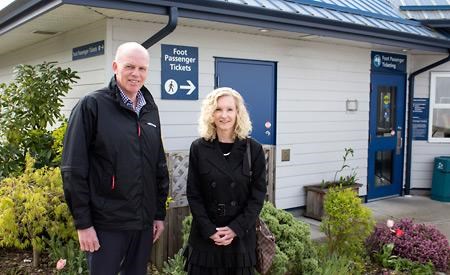Traffic and passenger levels on BC Ferries were up five and four per cent respectively during March with even greater gains recorded in February, the corporation reported on Wednesday, April 15.
Mike Corrigan, BC Ferries’ president and CEO, said the increases demonstrate the company is well-positioned going into the next four years, largely as a result of major operating cost reductions, lower fuel prices and a lower Canadian dollar.
The rebound in traffic numbers could signal a stronger summer for tourism on Vancouver Island and the Sunshine Coast, Corrigan added.
Corrigan and colleague Deborah Marshall, public affairs executive director, sat down with the Peak on Wednesday, April 15, while they were in town for annual staff meetings, to talk about BC Ferries’ future, challenges of running the service and to address some of the public’s criticism over fare affordability.
BC Ferries is an independent company that operates on a 60-year contract with the province to provide ferry service, Corrigan said. That contract has four-year renewable terms and the company has just completed its third four-year term.
At the end of each term the ferry corporation is required to file a cost of service and efficiency plan with the independent BC Ferry Commission which regulates fare increases.
Gord Macatee, BC Ferry commissioner, released his report for performance term three last month, which Corrigan said “dispels a number of myths around BC Ferries—that there are too many managers who are paid too much with overhead executive costs out of control.”
Corrigan said executive compensation has been reduced by $1.2 million each year since 2009 and the corporation has cut the number of executives in half. Administrative costs have been reduced by about 15 per cent or $5 million since 2009, he added.
By the end of the year, BC Ferries expects to have cut costs by about $84 million over the past four years, approximately $30 million more than the efficiency target set in 2009 by the ferry commissioner.
Fuel costs have been reined in through daily monitoring of fuel usage and using vessels that are more efficient but still meet demand. Fuel consumption has dropped approximately 1.3 per cent since 2009.
He added that these factors, as well as others, helped spur Macatee’s recent decision to cap fare increases at 1.9 per cent over each of the next five years.
“I realize there are a lot of people who say they want to see fares reduced or held constant, but in our world where we are investing $3 billion in new ships, terminals and new [information technology] infrastructure, we don’t think that’s realistic,” Corrigan said. “We’re trying to keep the system sustainable and up to world-class standards over the long term and that’s costly to do.”
He acknowledged that fare increases continue to concern coastal communities, but warned that negative coverage in the media about fare levels could push potential international and Canadian visitors to make different holiday plans without taking the time to investigate the costs further.
And in response to the public criticism that the ferry service should run in a leaner, more stripped -down way, Corrigan explained that the ship’s on-board amenities like cafeterias, gift shops, lounges and vacation packages bring in much needed revenue for the company. If they were cut, fares would need to increase substantially to soak up the annual approximately $50 million loss of revenue, he said.
The corporation has had to look to other avenues for increased operating money and is seeing an increase in its drop trailer service which was introduced in 2009. It allows commercial customers to drop trailers at one location and BC Ferries transports them by ferry to another terminal for pickup. The service brought in $8 million during the 2014 fiscal year and is expected to increase by close to $1 million over the next two years.
Corrigan said BC Ferries is planning to rebuild the company’s entire passenger reservation and point-of-sales system. “We need to have a new booking, ticketing and check-in system, more e-commerce solutions, better website and better pricing opportunities for customers, which we can’t do right now.”



